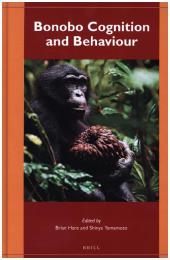 Neuerscheinungen 2016Stand: 2020-02-01 |
Schnellsuche
ISBN/Stichwort/Autor
|
Herderstraße 10
10625 Berlin
Tel.: 030 315 714 16
Fax 030 315 714 14
info@buchspektrum.de |

Brian Hare, Shinya Yamamoto
(Beteiligte)
Bonobo Cognition and Behaviour
Herausgegeben von Yamamoto, Shinya
2016. VI, 323 S. 235.0 mm
Verlag/Jahr: BRILL 2016
ISBN: 9004304169 (9004304169)
Neue ISBN: 978-9004304161 (9789004304161)
Preis und Lieferzeit: Bitte klicken
This volume includes twelve novel empirical papers focusing on the behaviour and cognition of both captive and wild bonobos ( Pan paniscus ).
Overall it demonstrates how anyone interested in understanding humans or chimpanzees must also know bonobos.
This volume includes twelve novel empirical papers focusing on the behaviour and cognition of both captive and wild bonobos ( Pan paniscus ). As our species less known closest relative, the bonobo has gone from being little studied to increasingly popular as a species of focus over the past decade. Overall this volume demonstrates how anyone interested in understanding humans or chimpanzees must also know bonobos. Bonobos are not only equal to chimpanzees as our relatives, but they are also unique.
The majority of papers in this volume show that whether you are interested in the evolution of culture and tool use, social relationships and sharing or foraging ecology and cognition, bonobos have a major contribution to make. Four papers provide further evidence that the behaviour and psychology of bonobo females is radically different from that observed in chimpanzees. Foraging behaviour and cognition of bonobos is the focus of three papers that each show important ways that bonobos spatial cognition differs remarkably from chimpanzees. Two papers are relevant to solving the puzzle of why bonobos are expert extractive foragers in captivity but have never been seen using tools to obtain food in the wild.
The articles presented in this volume are previously published in a Special Issue of Behaviour , Volume 152, Parts 3-4 (March 2015).
Moving bonobos off the scientifically endangered list
Brian Hare and Shinya Yamamoto
Relationship quality in captive bonobo groups
Jeroen M.G. Stevens, Evelien De Groot and Nicky Staes
Prolonged maximal sexual swelling in wild bonobos facilitates affiliative interactions between females
Heungjin Ryu, David A. Hill And Takeshi Furuichi
Sex and strife: post-conflict sexual contacts in bonobos
Zanna Clay and Frans B.M. De Waal
Non-reciprocal but peaceful fruit sharing in wild bonobos in Wamba
Shinya Yamamoto
Can fruiting plants control animal behaviour and seed dispersal distance?
David Beaune, Fran‡ois Bretagnolle, Lo‹c Bollache, Gottfried Hohmann and Barbara Fruth
Context influences spatial frames of reference in bonobos (Pan paniscus)
Alexandra G. Rosati
The influence of testosterone on cognitive performance in bonobos and chimpanzees
Victoria Wobber and Esther Herrmann
Why do wild bonobos not use tools like chimpanzees do?
T. Furuichi, C. Sanz, K. Koops, T. Sakamaki, H. Ryu, N. Tokuyama and D. Morgan
A comparative assessment of handedness and its potential neuroanatomical correlates in chimpanzees (Pan troglodytes) and bonobos (Pan paniscus)
William D. Hopkins, Jennifer Schaeffer, Jamie L. Russell, Stephanie L. Bogart, Adrien Meguerditchian and Olivier Coulon
Bonobos and chimpanzees exploit helpful but not prohibitive gestures
Evan L. Maclean and Brian Hare
Preference or paradigm? Bonobos show no evidence of other-regard in the standard prosocial choice task
Jingzhi Tan, Suzy Kwetuenda and Brian Hare
Experimental evidence that grooming and play are social currency in bonobos and chimpanzees
Kara Schroepfer-Walker, Victoria Wobber and Brian Hare


